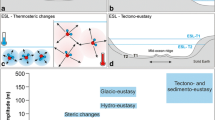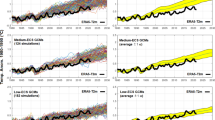Abstract
There has been considerable research to determine climate variability on the decadal timescale, primarily using temperature data1–11. In the tropical Pacific the dominant climate fluctuation is the E1 Niño-Southern Oscillation phenomenon12–14, which includes large anomalies in the wind field. The surface wind velocity is the meteorological variable most widely, and reliably, observed at sea and hence we have performed an analysis of sixty-four years of Pacific wind data. Here we report that the results show that during the period 1940–44 there was a strong westerly anomaly, of the order of 1 m s−1 in a climatology of 5 m s−1. This anomaly was concurrent with anomalies in sea surface temperature1 and Pacific sea-level pressure2. During this period the warming of the ocean and the westerly wind anomaly resemble a prolonged E1 Niño. We also show from the observations that, in the period 1950–81, there was a trend towards increasing trade winds over much of the Pacific Ocean. A similar trend has also been observed in Atlantic Ocean data3,15,16.
Similar content being viewed by others
References
1. Holland, C. K., Parker, D. E. & Kates, F. E. Nature 310, 670–673 (1984). 2. Barnett, T. P. Mon. Weath. Rev. 112, 303–312 (1984). 3. Arfl, R. Can. J. Fish, aquat. Sci. 42, 1969–1978 (1985). 4. Jones, P. D., Wigley, T. M. L. & Wright, P. B. Nature 322, 430–434 (1986). 5. Jones, P. D. et al. J. dim. appl. Met. 25, 161–179 (1986). 6. Jones, P. D., Wigley, T. M. L. & Kelly, P. M. Mon. Weath. Rev. 110, 59–72 (1982). 7. Vinnikoy, K. Ya et al Meteor. Gidrol 6, 5–17 (1980). 8. Saw, J. F. T. / appl. Met. 2, 417–425 (1963). 9. Paltridge, G. W. & Woodruff, S. Mon. Weath. Rev. 109, 2427–2434 (1981). 10. Paltridge, G. W. Mon. Weath. Rev. 112, 1093–1095 (1984). 11. Mitchell, J. M. Jr Ann. N.Y. Acad. Sci. 95, 235–250 (1961). 12. Rasmussen, E. M. & Carpenter, T. H. Mon. Weath. Rev. 110, 354–384 (1982). 13. Gill, A. E. & Rasmussen, E. M. Nature 306, 229–234 (1983). 14. Philander, G. Nature 302, 295–301 (1983). 15. Servain, J., Picaut, J. & Bussalachi, A. J. in Coupled Ocean-Atmosphere Models (ed. Nihoul, J.) 211–237 (Elsevier, Amsterdam, 1985). 16. Bunker, A. F. Mon. Weath. Rev. 108, 720–732 (1980). 17. Goerss, J. S. & Duchon, C. E. /. phys. Oceanogr. 10, 478–479 (1980). 18. Barnett, T. P. /. atmos. Sci. 34, 221–236 (1977). 19. Hess, S. L. Introduction to Theoretical Meteorology (Holt, Reinhart and Winston, New York, 1959). 20. Quinn, W. H., Zopf, D. O., Short, K. S. & Yang, R. T. W. Fishery Res. Bull. 76,663–678 (1978). 21. Ellsaesser, H. W., MacCracken, M. C., Walton, J. J. & Grotch, S. L. Rev. Geophysics 24, 745–792 (1986). 22. Folland, C. K., Palmer, T. N. & Parker, D. E. Nature 320, 602–607 (1986).
Author information
Authors and Affiliations
Rights and permissions
About this article
Cite this article
Whysall, K., Cooper, N. & Bigg, G. Long-term changes in the tropical Pacific surface wind field. Nature 327, 216–219 (1987). https://doi.org/10.1038/327216a0
Received:
Accepted:
Issue Date:
DOI: https://doi.org/10.1038/327216a0
- Springer Nature Limited
This article is cited by
-
Recent climatic trends in the tropical Atlantic
Climate Dynamics (2014)
-
Weakening of tropical Pacific atmospheric circulation due to anthropogenic forcing
Nature (2006)
-
Recent changes of the tropical water and energy budget and of midlatitude circulations
Climate Dynamics (1990)
-
Temperature and insolation trends in Hawaii
Theoretical and Applied Climatology (1988)





